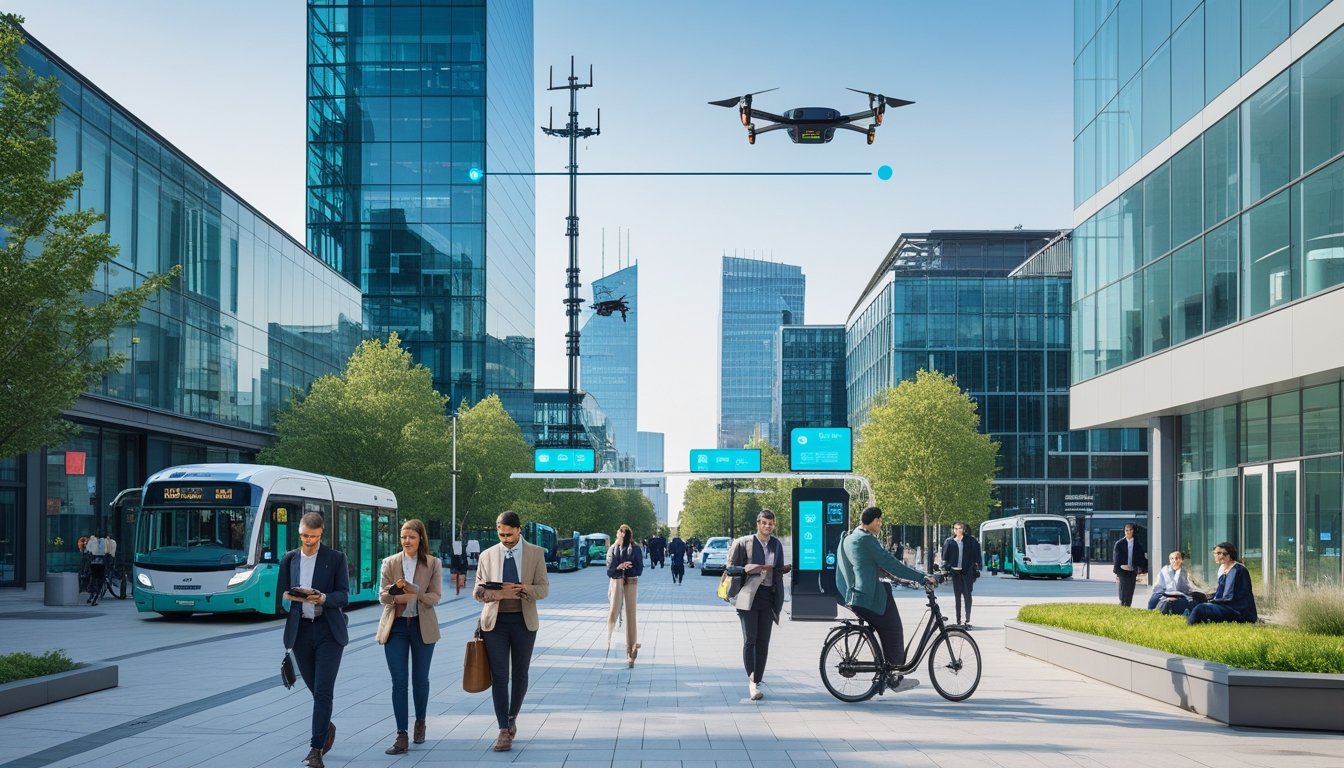Late updated: 17 Nov 2025 09:11
Written by: Oliver Bennett
Innovative Solutions for Enhancing UK's Urban Connectivity: A Comprehensive Overview
Innovative solutions are shaping the future of urban connectivity across the UK, propelling cities into an era of enhanced digital integration and sustainability. As we watch cities transform, it becomes clear that initiatives such as the deployment of 5G networks and the integration of smart infrastructure are laying the groundwork for smarter, more efficient urban environments. High-speed internet and advanced connectivity platforms are not just luxuries but essential tools driving economic growth and improving citizens' daily lives.

The push for better urban connectivity isn't just about having faster internet; it's about unlocking the potential of technology to solve urban challenges. By deploying city-wide multi-operator wireless networks and enhancing infrastructure, we are preparing our cities to adapt to the digital demands of the future. This shift towards connected urban mobility aims to bridge the digital divide, ensuring that every individual and institution has access to critical resources and information.
With significant investment in improving connectivity, the UK is poised to take a leading role in digital transformation. A strong foundation of robust connectivity is not only fostering innovation but is also setting the stage for more sustainable urban living. As we delve deeper into the transformative power of connectivity, it becomes evident that the possibilities are vast and hold the promise of a brighter urban future.
Key Takeaways
- Enhancing urban connectivity is crucial for economic growth.
- Smart infrastructure is transforming UK cities into smarter spaces.
- Robust connectivity fosters innovation and sustainability.
Innovative Technologies Transforming Urban Connectivity in the UK

In today's digital age, innovative technologies are at the forefront of transforming urban connectivity across the UK. Through the deployment of 5G infrastructure, smart city developments, IoT applications, and edge computing, cities are progressively becoming more interconnected and efficient. These technologies are essential in supporting sustainable economic growth and enhancing the quality of life for urban residents.
5G Infrastructure and Small Cell Deployment
5G infrastructure is crucial to the UK's digital transformation, promising unprecedented improvements in mobile connectivity and service quality. The deployment of small cells is particularly significant here. These low-powered radio access nodes complement traditional towers, boosting mobile network capacity and coverage, especially in densely populated urban areas.
Small cells enable faster and more reliable internet access, facilitating innovations such as augmented reality and smart traffic management. Our cities must continue investing in 5G infrastructure to maintain competitive growth and development. The government's proactive approach in funding research and development for 5G connectivity solutions demonstrates a strong commitment to a connected future.
Smart Cities and Digital Services
The concept of smart cities is reshaping urban living by integrating information and communication technologies into infrastructure. The aim is to streamline services and increase efficiency. Digital services, ranging from smart lighting to traffic optimisation, contribute to the creation of sustainable and responsive urban environments.
Collaboration between public and private entities is essential to building smart cities. Government initiatives encouraging this collaboration are crucial in deploying efficient digital infrastructure. Through such partnerships, we can develop applications that cater to the needs of all citizens, enhancing their daily lives through improved service provision.
IoT Sensors and Applications
IoT sensors have become pivotal in transforming urban landscapes by facilitating real-time data collection and analysis. These sensors are embedded in various systems, such as traffic lights and public transport, providing essential information that aids in decision-making. Their applications are vast, from monitoring air quality to managing waste more effectively.
IoT's impact extends to increasing operational efficiency and reducing costs. By leveraging the data collected, cities can optimise resources, enhance service delivery, and improve the overall quality of life. We must continue to expand the use of IoT technologies to foster even smarter urban environments.
Edge Computing for Real-Time Urban Solutions
Edge computing is gaining traction as a vital component in enhancing urban connectivity. By processing data closer to its source, edge computing reduces latency, making it ideal for real-time applications. This capability is crucial for ensuring the smooth operation of critical urban systems, such as emergency response units and autonomous vehicles.
As cities adopt more IoT devices, the importance of edge computing grows. It offers an efficient way to handle vast data volumes while minimising the strain on centralised servers. This technology supports robust and scalable urban connectivity solutions, paving the way for innovative services and applications.
Sustainable and Connected Urban Mobility
In the UK, urban connectivity is undergoing significant transformation through sustainable and connected mobility solutions. Key developments include innovative public transport, autonomous vehicles, and digital connectivity, which help reduce congestion and pollution while enhancing well-being and access to public services.
Public Transport Innovation and Autonomous Vehicles
Our cities are investing heavily in modernising public transport systems, focusing on sustainability and connectivity. Autonomous vehicles represent a breakthrough, offering efficient public transport solutions with the potential to reduce traffic and emissions. Electric buses and trams are increasingly adopted, as they provide clean, quiet operations that align with sustainability goals.
Digital connectivity enhances these innovations by integrating IoT applications and real-time data to improve service efficiency. Through smart scheduling, passengers experience reduced waiting times and enhanced journey planning. Public transport is set to become more accessible, reliable, and environmentally friendly as part of our urban mobility strategy.
Reducing Congestion and Pollution through Connectivity
Congestion and pollution pose significant challenges for urban environments. We are tackling these issues by leveraging advanced connectivity technologies. Smart traffic management systems optimise traffic flow using real-time data to reduce bottlenecks and idle time on the roads. This connectivity decreases emissions and mitigates air pollution in densely populated areas.
Car-sharing platforms and vehicle-to-everything (V2X) technologies further alleviate traffic congestion by promoting shared transport modes and improving the coordination of autonomous vehicles with infrastructure. Through these smart solutions, our cities are becoming more efficient and less polluted, contributing to a healthier urban atmosphere.
Enhancing Well-Being and Access to Public Services
Sustainable urban mobility also focuses on enhancing the well-being and accessibility of public services. Efforts include the development of pedestrian-friendly infrastructure and bicycle-sharing schemes, which encourage healthier, active lifestyles while reducing vehicular traffic.
Connected technologies play a pivotal role in offering seamless access to essential services, such as healthcare and education, by reducing travel times and improving the integration of transport networks. Enhanced mobility options increase equity by ensuring all residents have convenient access to public services, fostering overall community well-being and economic growth.
Frequently Asked Questions

In the pursuit of enhancing the UK's urban connectivity, various strategies and technologies are being adopted. Efforts include improving public transport systems, integrating smart technologies, reducing traffic congestion, prioritising environmental sustainability, exploring funding opportunities, and fostering government-private sector collaboration.
What strategies are being implemented to improve public transport systems in urban areas?
We are witnessing significant upgrades to public transport systems across urban areas. Key strategies include the deployment of smart ticketing systems, expansion of public transport networks, and enhancements to rail and bus services to increase efficiency and accessibility. These measures aim to provide a more seamless and reliable commuting experience.
How are smart technologies being integrated into the United Kingdom’s urban transport networks?
Smart technologies are revolutionising the UK’s urban transport networks. Innovations such as real-time data analytics, IoT, and AI applications are being utilised to monitor traffic patterns, optimise routes, and improve transit management systems. This integration supports an efficient and responsive transport infrastructure.
What are the current challenges faced in reducing traffic congestion within cities?
One of the primary challenges we face in tackling urban traffic congestion is the growing population density, which perpetually increases vehicle numbers on the roads. Additionally, the infrastructure in many cities struggles to keep pace with current demands, resulting in bottlenecks and delays.
In what ways is the UK prioritising environmental sustainability in its urban connectivity development?
The UK's approach to sustainable urban connectivity includes promoting eco-friendly transport modes like electric buses and cycling. Additionally, investments are being made in renewable energy sources for public transport and infrastructure, aiming to reduce carbon footprints and encourage cleaner travel options.
What funding and investment opportunities exist for urban connectivity projects?
Funding opportunities for urban connectivity projects are available through government initiatives, public-private partnerships, and international investors. Various grants and incentives are designed to support research, development, and implementation of innovative connectivity solutions in urban areas.
How is the government collaborating with private sector partners to enhance urban transportation?
The government actively collaborates with private sector partners to enhance urban transportation through joint ventures and strategic partnerships. These collaborations often lead to infrastructure development projects, advanced technology integration, and the creation of innovative transport solutions that benefit the public sector and private entities alike.
